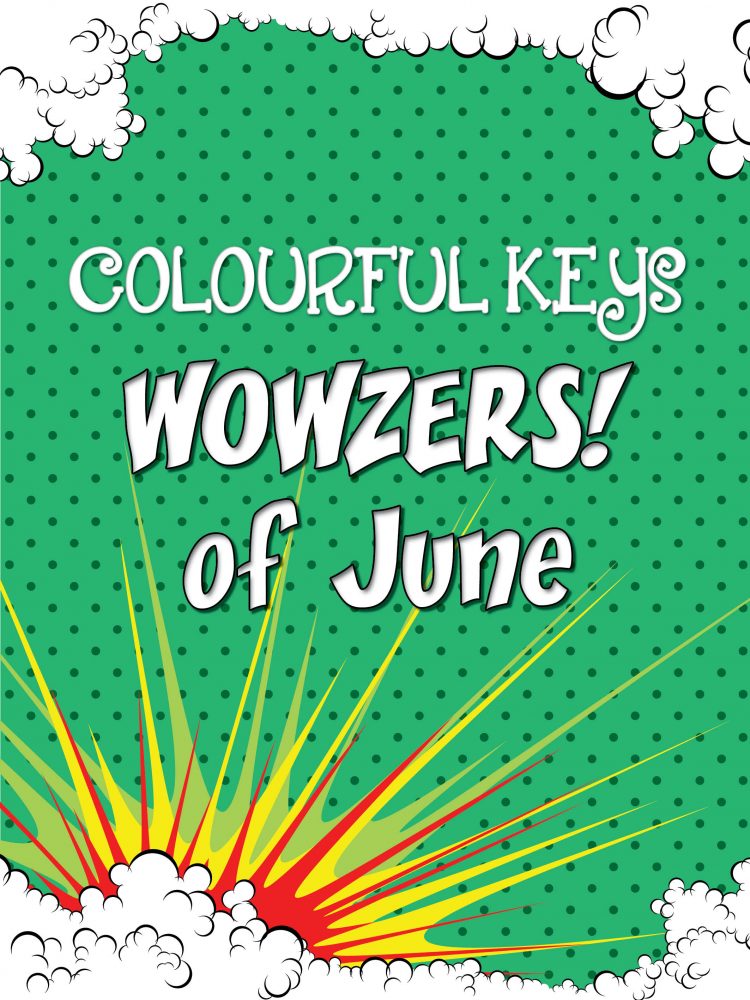I don’t know if you’ve noticed, but I’m a little obsessed with learning. I read & listen to anything and everything I can get my hands on that might make me a better piano teacher. I’m constantly reading/watching/listening to piano teaching resources.
Some of these are a bit meh, some of it is pretty great and some of it makes me say WOWZERS.
(Not sure if that’s an Irish thing, but I think you can grasp the sentiment…i.e. not just a wow but a wowzer! 😉 )
So! I’ve decided to start a new little tradition on the Colourful Keys blog called WOWZERS of the Month. I’ll be sharing my top three piano teaching resources that are inspiring me each month and maybe some of them will make you say WOWZERS too! (Or just “Wow!” if that’s more your style.)

To qualify as a WOWZER something has to either open me up to a completely new idea or make me think about something I already know in a new way. It could be a blog post, book, game, podcast episode…anything that gives me a mini-epiphany.
Let’s get one thing out of the way. No one has asked me to write about these resources, however some of the links in this post are affiliate links. This doesn’t cost you anything but means that Amazon will send me a small commission for sending a customer their way. These commissions help me to keep this site running, so thank you!
Got it? Great! Let’s kick this off with my WOWZERS of June.
Rhythm: One on One
I picked this book up after listening to the Tim Topham’s podcast with Paula Melville Clark and it is a gem. It’s packed full of simple and straight forward rhythm activities that you can use in your piano lessons right away.
There is some suggested equipment at the start of the book, but you don’t really need any of it. If there’s something I don’t have I can always find a substitution from something around the house.
My favourite thing about this book is that you don’t need to change up a whole lesson plan. The ideas in here are super adaptable and you can just take one idea each week and use it in several different students’ lessons.
Then the next week take another idea to run with. Easy breezy.
I actually started just reading one of the activities with my morning coffee, and then trying to find one student to use it with that day. Before you know it you have a whole memory bank of ways to use movement in your piano teaching.
You don’t need to sit and read this book straight through at all. Just dip in and out over time and have fun with it!
Piano Safari Rote & Technique Exercises
 I have yet to try out the full Piano Safari method as it’s still a little pricey to ship to Europe (they do seem to be working on a solution to that).
I have yet to try out the full Piano Safari method as it’s still a little pricey to ship to Europe (they do seem to be working on a solution to that).
However I did get the Technical Exercises and Rote Pieces book a little while back and I’m loving it. I started experimenting with this book a few months ago and I’ve had some great successes.
One student this has really helped is a girl with dyslexia, dyspraxia and some sensory processing issues who just transferred to me in January.
She was doing OK with her previous teacher, but she was lacking confidence and was really reading mostly by finger number. We had to backtrack a bit in her reading to fill in the gaps.
While we were working on reading by interval (using Interval Wizard Cards among other things), I added in the Piano Safari pieces for some variety and as a way to work on technique without the added stress of reading.
I don’t think I can emphasise enough how much she has enjoyed these pieces, and how big the improvement has been. She performed in our May concert (a very big deal for her and her parents) and the tension is starting to disappear from her playing as well.
I really like the use of the rote pieces in these books, but my favourite thing about the Piano Safari series is the animal imagery used in the technique exercises. Bringing this story telling aspect into an area of piano playing that can sometimes be a little dry has moved this part of the lesson from least to most favourite (and given us some great giggles too 😀 ).
Full Voice Podcast: Strategies for Shy Singers
I think the voice should be part of all music lessons. I’m not a trained singer myself, but I sing along to my student’s pieces and encourage them to sing too.
When we get students singing they become better listeners. And I want good listening skills to be included in all my students’ musical training. Singing makes for more expressive performances, more durable memorising and overall more engagement in music.
But some students (especially transfers and older beginners) just do not want to sing.
Like I said, I’m not a singing teacher. I’m not even a great singer. That’s why I loved these tips on the Full Voice Podcast with Nikki Loney.
It was great to hear what a singing teacher does to help shy singers.
There were some things Nikki mentioned that I was already doing (nice to know I’m on the right track!) and some ideas that were completely new to me. My favourite tip was the idea of giving numerical feedback to get students to sing louder.
“That’s only 50% of your voice, I need at least 77%.”
It’s a great way to make it fun while giving your student some specifics on what you need from them.
Take a listen and see if you can bring some of your own students out of their singing shell.
What piano teaching resources WOWed you this month?
Was there a podcast, book, blog post or video that made you stop and think? Something new that you were amazed you didn’t know before?
Did you find some new inspiration in today’s post?
Leave your favourite resource in the comments, I’d love to see what’s fueling your teaching fire this month!

HI Nicola! Yea for the new series! I have a similar series going on over on my blog called Friday Finds where I share my top 10 finds for the week! I’ll look forward to seeing your top resources every month! I love podcasts and used to be a choir teacher so I’m excited to try out the Full Voice Podcast.
Hey Amy! Great to see you here, loved your marketing webinar! Definitely check out that podcast, I really like the host Nikki Loney very down to earth and much of her advice and insights would work for any music teacher. 🙂